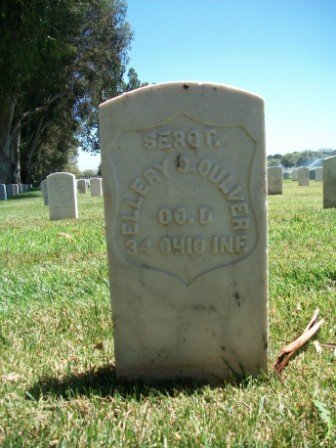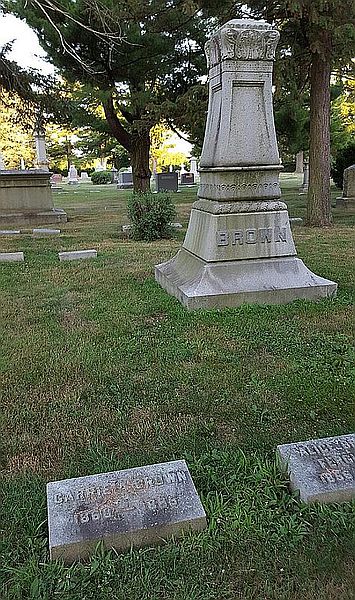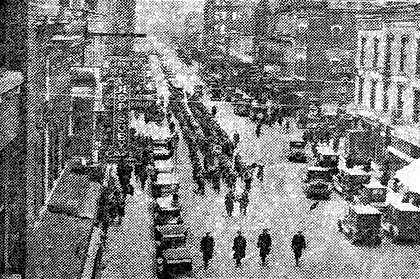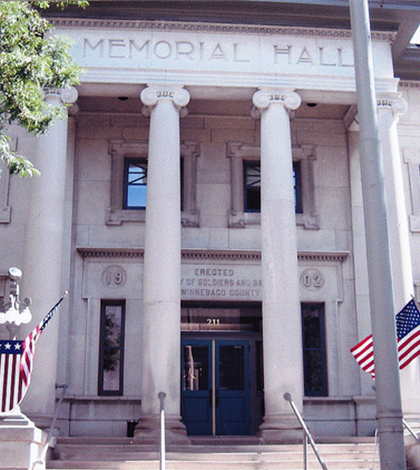Some of you may know that I travel all over the country to visit haunted historical locations. I am very blessed to have a partner that never hesitates to drive the “road less traveled”. We have ended up in some pretty amazing places and have experienced many adventures together.
This story is about one of these adventures. This past fall we headed toward Yellowstone National Park. I visited the Rockford Public Library and checked out several tour guides for the park and surrounding areas.
I am always astonished to find ghost stories in the most unusual places. One of the books mentioned that there are several grave sites in the park beyond the cemeteries of Fort Yellowstone and Kite Hill. One of the graves that caught my attention was the story of Mattie Shipley Culver who died in March of 1889.

Her grave was not inside one of the cemeteries but stood all alone close to the Nez Perce Picnic Area inside of the park itself. At first I was curious about why a woman would be buried there all alone with no other family members close by. I became fascinated with Mattie and felt compelled to learn her story.
She was born Martha Jane Shipley on September 18, 1856 in Massachusetts. Her family was very poor and Mattie (as her family called her) started to work in the dirty textile factories as a young child. Her parents divorced when she was seven causing even more hardship for the little girl. Mattie lived with her father after the break up of the marriage. When he was killed during the Civil War, Mattie was passed around to several family members.
Mattie grew to be a lovely young woman with very limited resources. She and her sister, Nellie would spend hours dreaming of far-off places away from the crowded city. Their dreams became possible when Nellie met a young man named David Alston. David made the sisters feel like they could have the life they had visioned. The three decided to leave the crowded cities of the east coast behind and headed toward the west. They settled in Pease Bottom, Montana.
It was in Montana that Mattie first fell in love. The man’s name was Eugene Gillette. Mattie’s happiness was short lived, however. She must have been heart broken when Eugene contracted tuberculosis and died one year after their wedding. Mattie’s devotion and care for her young husband impressed all who knew her.
Mattie next met a dashing young man by the name of Ellery C. Culver. Ellery was an adventurer that had left his home state of New York and traveled west. He served in the Civil War in the Ohio Infantry. Though the details of their meeting have been lost to time, stories tell of how the widowed Ellery was taken with the beautiful twenty six year old Mattie. Records show that the couple was married in Yellowstone, Montana in 1886.
The young couple welcomed their first child in June of 1887. They named the little girl Theda after Ellery’s sister. The couple must have thought all of their dreams were coming true when Ellery was offered a job through the Yellowstone Park Association as the Master of Transportation. He had to leave Mattie and the newborn behind until he could make things ready for them in their new home.
Ellery established their new living quarters at the Firehole Hotel, set in a beautiful location on the Firehole River. Mattie was filled with excitement when she left Billings on July 26, 1886. She was moving to a beautiful location with her husband and her daughter to begin their new life together. Mattie thoughts probably wandered back to the nights spent with her sister when they talked of their future lives far away from the dirty factories of the city.
Both Ellery and Mattie must have felt blessed as they settled into their new surroundings. Mattie helped Ellery with his duties at the hotel and they shared many happy days watching their little girl playing among the pine trees.
Mattie probably knew from the beginning that she had tuberculosis. She had nursed her first husband through the dreaded disease and knew the symptoms all too well. She might have even known before the trip to Yellowstone and hoped the clean mountain air would save her.
Mattie would put on a brave face for her husband but she began to spend more and more time walking along the banks of the Firehole River. All too soon, the disease progressed until Mattie could not hide the symptoms any longer. The couple had to face their worst fears and on a cold winter day in the beginning of March, 1889, Mattie drew her last breath. Ellery was grief stricken and unsure what to do with himself. There also was the matter of Mattie’s body. The deep snow and frozen ground meant that burial would need to be postponed.
Mattie was well loved through the area and several soldiers came to assist her family. They brought along two barrels to place end to end. They gently placed Mattie’s body inside and covered her with snow. Mattie’s official burial was not conducted for almost two weeks later.
Ellery knew that Mattie loved the area around the river and he made the decision that she would rest there under the pines. He built her a coffin from wood that was once a partition from their rooms. Ellery had a beautiful head stone designed and shipped to place on her grave so that all who wandered past the place would know of Mattie and his love for her. Ellery was due to leave the area in the spring but he made the soldiers and others inside the park promise to look after Mattie’s grave until his return. He took Theda to Mattie’s sister’s home while he traveled from station to station for his duties. Ellery often returned to the lovely area to visit Mattie’s grave. He would work three more years in Yellowstone before moving away.
Even after the rest of the family left Yellowstone, people continued to see Mattie. She often was seen walking by the river she loved. Some even heard her lovely voice singing lullabies as they walked among the pine trees. Those who drew close to see her face spoke of her beauty and the incredible sadness that filled her eyes.
Unfortunately, Mattie’s death would not be the only tragedy in Ellery’s life. In 1906, nineteen year old Theda lived with her Aunt Nellie in Spokane, Washington. She became ill and died suddenly. Ellery seemed broken by this final loss and retired to a Old Soldiers home in California.
 Finally, in 1922, Ellery knew his time was drawing short and he spoke to all who would listen that his final wish was to be laid to rest next to his beloved wife. This wish was denied and after his death on April 7, 1922, Ellery was buried in the National Soldiers Home Cemetery in what is now Los Angeles, California.
Finally, in 1922, Ellery knew his time was drawing short and he spoke to all who would listen that his final wish was to be laid to rest next to his beloved wife. This wish was denied and after his death on April 7, 1922, Ellery was buried in the National Soldiers Home Cemetery in what is now Los Angeles, California.
Though his body may lie many miles from Mattie, some say that Ellery’s spirit has joined hers in Yellowstone. Travelers in the area now speak of not one spirit but two. Witnesses tell of spotting two people dressed in older period clothing walking hand in hand by the beautiful river, especially in the evening hours right before sunset.
As I walked where Mattie and her family once lived so long ago, I was once again touched by her story. I noticed the untouched beauty of the spot and also realized that this location, like so many I have been fortunate enough to visit through the years, holds its place in time. The veil between the present and the past is very thin here and it is possible to envision the way things once were.
For more details of the fascinating life of Mattie Culver, see the book “Mattie, A Woman’s Journey West” by Nan Weber, https://nanweber.com/my-book-page
If you would like to read more about the people who settled Yellowstone (and their ghosts!) I would recommend the following two books. “Death In Yellowstone” by Lee H. Whittlesey describes some of the mishaps, accidents and other means of demise that have befallen visitors and staff throughout the years and “Yellowstone Ghost Stories” by Shellie Larios tells of the spiritual inhabitants as well as some of the legends that have been passed down.
Copyright © 2016 Kathi Kresol, Haunted Rockford Events



 Carrie Brown was born in August of 1860 to parents Horace and Mary August. Carrie was her parents pride and joy. She was described as being remarkably handsome and as one of Rockford’s fairest daughters.
Carrie Brown was born in August of 1860 to parents Horace and Mary August. Carrie was her parents pride and joy. She was described as being remarkably handsome and as one of Rockford’s fairest daughters.
 The people that lived on Pershing Avenue all knew each other. This was pretty typical in Rockford in 1961. It was a different city back then. People knew and looked out for their neighbors. So it wasn’t surprising that it was the neighbors who notified the police that they hadn’t seen their neighbors in a few days.
The people that lived on Pershing Avenue all knew each other. This was pretty typical in Rockford in 1961. It was a different city back then. People knew and looked out for their neighbors. So it wasn’t surprising that it was the neighbors who notified the police that they hadn’t seen their neighbors in a few days.
 Frank Cichella’s life in Rockford was pretty typical for the early 1900s. He wasn’t from Rockford originally. In fact, he wasn’t from the United States. Frank came here when he was 16 years old, leaving his home of Ferentino, Italy. He traveled on the S.S. Re D’Italia from Naples to Philadelphia to live with his brother in 1907. It is not known when and why he came to Illinois, but he was here by 1912. Frank married Mary Fromo in 1912 in Rockford when he was 21.
Frank Cichella’s life in Rockford was pretty typical for the early 1900s. He wasn’t from Rockford originally. In fact, he wasn’t from the United States. Frank came here when he was 16 years old, leaving his home of Ferentino, Italy. He traveled on the S.S. Re D’Italia from Naples to Philadelphia to live with his brother in 1907. It is not known when and why he came to Illinois, but he was here by 1912. Frank married Mary Fromo in 1912 in Rockford when he was 21.


 “Time heals all wounds” is a familiar saying, and while it may work that way for some things, even time can’t heal the wounds that the families of Stan Skridla and Mary Jane Reed have suffered. It has been 66 years since the two young people were found murdered, and while there has been much speculation and many accusations, no one has ever been arrested for the crimes. The only thing the people involved in the investigation can agree on is that on the evening of Thursday, June 24, 1948, these two people were attacked.
“Time heals all wounds” is a familiar saying, and while it may work that way for some things, even time can’t heal the wounds that the families of Stan Skridla and Mary Jane Reed have suffered. It has been 66 years since the two young people were found murdered, and while there has been much speculation and many accusations, no one has ever been arrested for the crimes. The only thing the people involved in the investigation can agree on is that on the evening of Thursday, June 24, 1948, these two people were attacked.
 The Camp Grant Museum and Command Post Restaurant is a treasure trove of interesting history told through actual artifacts of the men and women who served at Camp Grant. It is owned by Stanley and Yolanda Weisensel. They have spent many years scouring the area on a quest to build a memorial to the people who traveled through this area on the way to serve our country in World Wars I and II.
The Camp Grant Museum and Command Post Restaurant is a treasure trove of interesting history told through actual artifacts of the men and women who served at Camp Grant. It is owned by Stanley and Yolanda Weisensel. They have spent many years scouring the area on a quest to build a memorial to the people who traveled through this area on the way to serve our country in World Wars I and II.
 In 1899, the well-known local soldier, Thomas G. Lawler, who was the Commander of the G.A.R. (Grand Army of the Republic), Garret L. Nevius Post No. 1, submitted a petition to the Winnebago County Board. The petition, signed by 200 men, was a request for a building specifically for veterans. This building, named the Veterans Memorial Hall, was finished in 1903. It was the first ever of its kind built in Illinois, and according to some sources, the entire United States. Its purpose was “to serve as a constant reminder to all of the sacrifices given by the brave men and women from Winnebago County and a way for following generations to remember and learn about their lives.”
In 1899, the well-known local soldier, Thomas G. Lawler, who was the Commander of the G.A.R. (Grand Army of the Republic), Garret L. Nevius Post No. 1, submitted a petition to the Winnebago County Board. The petition, signed by 200 men, was a request for a building specifically for veterans. This building, named the Veterans Memorial Hall, was finished in 1903. It was the first ever of its kind built in Illinois, and according to some sources, the entire United States. Its purpose was “to serve as a constant reminder to all of the sacrifices given by the brave men and women from Winnebago County and a way for following generations to remember and learn about their lives.”
 Now known as Tinker Swiss Cottage Museum and Gardens, this beautiful mansion and its grounds are tucked away on Rockford’s west side. Quite a few Rockfordians know it is there, and some of them even know its history. What some of you might not know is that it has the reputation of being haunted!
Now known as Tinker Swiss Cottage Museum and Gardens, this beautiful mansion and its grounds are tucked away on Rockford’s west side. Quite a few Rockfordians know it is there, and some of them even know its history. What some of you might not know is that it has the reputation of being haunted!
 This story could be a screenplay from the golden days of Hollywood, when men like John Wayne and Jimmy Stewart rode the wild frontier and saved their town from the clutches of the lawless bandits.
This story could be a screenplay from the golden days of Hollywood, when men like John Wayne and Jimmy Stewart rode the wild frontier and saved their town from the clutches of the lawless bandits.
 Mr. and Mrs. Damon must have felt a great relief when the armistice was completed and World War I finally seemed to be over. They had two sons serving in the war, Sgt. Clinton Damon, who was a member of Company C 1st Battalion, and Cpl. Grant Damon, who was in Company K 129th Infantry Division. Clinton was in the replacement and training camp in Texas, and Grant was overseas in France fighting on the Western Front.
Mr. and Mrs. Damon must have felt a great relief when the armistice was completed and World War I finally seemed to be over. They had two sons serving in the war, Sgt. Clinton Damon, who was a member of Company C 1st Battalion, and Cpl. Grant Damon, who was in Company K 129th Infantry Division. Clinton was in the replacement and training camp in Texas, and Grant was overseas in France fighting on the Western Front.